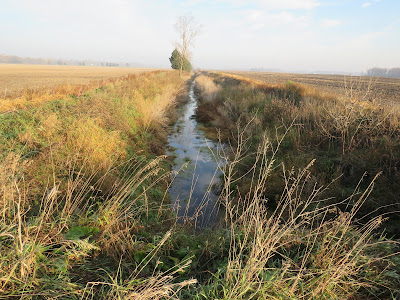Under sunny skies with temperatures in the upper 40’s, I’m standing on the Pierce Rd. bridge, watching a muskrat swim south along a narrow channel of Pine Creek that looks a lot like the hundreds of drainage ditches seen throughout Gratiot County. Classified as omnivores, muskrats mainly consume roots, stems, leaves, and fruits of aquatic vegetation. Once these are depleted, they will eat insects, fish and amphibians. These mammals remain active during the winter, foraging for food, since they do not store any in their lodges. In addition, they are among a few animals that regularly defecate in water where their droppings often contain a protozoan parasite that can cause a flu-like infection that old-time trappers referred to as “beaver fever.” Moving down to the water’s edge, I spot some raccoon tracks in the mud as well as one of their food sources. Moving south along the bank, I’m alarmed to see nearby cropland covered with fresh manure, allowing animal waste easy access to the creek. Further along, I spot a Muskrat resting on the far shore. Michigan’s culinary connection to muskrats began in the 1780’s, when French Catholics from Detroit settled in Monroe County. Historical records describe many residents consuming meat from a variety of sources, including abundant muskrats living along the riverbanks. However, since Lenten rules prohibited the eating of meat, Fr. Gabriel Richard, granted a special dispensation to the region’s Catholics allowing them to consume muskrat. Thus, muskrat dinners became a common occurrence both in the Downriver area and Monroe County (stock photo). St. Charles church in Newport has the longest running muskrat dinner in the region, which has taken place for the past 53 years on the Friday before Super Bowl Sunday. Returning to the car, I drive north and park next to the Filmore Rd. bridge to watch the Pine Creek flow south along the edge of the massive Vanderploeg Holstein farm where 3000 cows, crowded into pens, are milked daily. Given the amount of animal waste produced there, I’m wondering how much of it makes its way into the creek. Exploring the banks, I notice several patches of large green leaves. These are the basal leaves of Burdock that grow during the first year of this biennial plant’s life cycle. In the second year, these plants put out tall, erect stems that display pink to purplish flowers at the top of a spiny ball of hooked bracts, or burs that eventually dry out and turn brown.
Gone from the fields
The luster of gold
Sunshine of summer
Has now turned cold
Gone are Redwings
That ruled the marsh
Winds of November
Blow wild and harsh
Gone is the green
Of leaves and vines
Tales of nature
Mid-autumn signs
D. DeGraaf

No comments:
Post a Comment